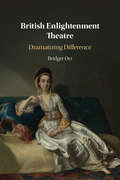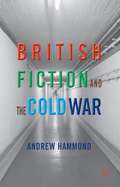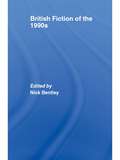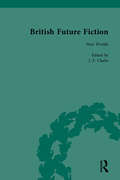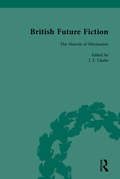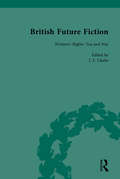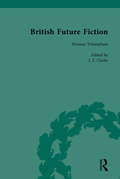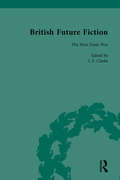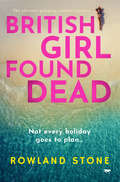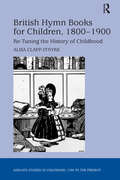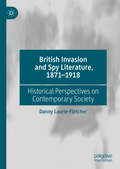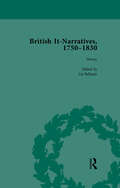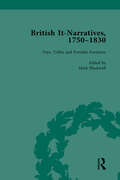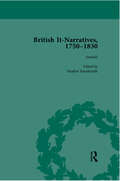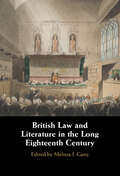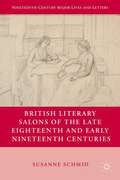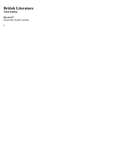- Table View
- List View
British Enlightenment Theatre: Dramatizing Difference
by Bridget OrrIn this ground-breaking work, Bridget Orr shows that popular eighteenth-century theatre was about much more than fashion, manners and party politics. Using the theatre as a means of circulating and publicizing radical Enlightenment ideas, many plays made passionate arguments for religious and cultural toleration, and voiced protests against imperial invasion and forced conversion of indigenous peoples by colonial Europeans. Irish and labouring-class dramatists wrote plays, often set in the countryside, attacking social and political hierarchy in Britain itself. Another crucial but as yet unexplored aspect of early eighteenth-century theatre is its connection to freemasonry. Freemasons were pervasive as actors, managers, prompters, scene-painters, dancers and musicians, with their own lodges, benefit performances and particular audiences. In addition to promoting the Enlightened agenda of toleration and cosmopolitanism, freemason dramatists invented the new genre of domestic tragedy, a genre that criticized the effects of commercial and colonial capitalism.
British Experimental Women’s Fiction, 1945—1975: Slipping Through the Labels
by Andrew Radford Hannah Van HoveThis book scrutinizes a range of relatively overlooked post-WWII British women writers who sought to demonstrate that narrative prose fiction offered rich possibilities for aesthetic innovation. What unites all the primary authors in this volume is a commitment to challenging the tenets of British mimetic realism as a literary and historical phenomenon. This collection reassesses how British female novelists operated in relation to transnational vanguard networking clusters, debates and tendencies, both political and artistic. The chapters collected in this volume enquire, for example, whether there is something fundamentally different (or politically dissident) about female experimental procedures and perspectives. This book also investigates the processes of canon formation, asking why, in one way or another, these authors have been sidelined or misconstrued by recent scholarship. Ultimately, it seeks to refine a new research archive on mid-century British fiction by female novelists at least as diverse as recent and longer established work in the domain of modernist studies.
British Fiction and the Cold War
by Andrew HammondThis book offers a unique analysis of the wide-ranging responses of British novelists to the East-West conflict. Hammond analyses the treatment of such geopolitical currents as communism, nuclearism, clandestinity, decolonisation and US superpowerdom, and explores the literary forms which writers developed to capture the complexities of the age.
British Fiction of the 1990s
by Nick BentleyThe 1990s proved to be a particularly rich and fascinating period for British fiction. This book presents a fresh perspective on the diverse writings that appeared over the decade, bringing together leading academics in the field. British Fiction of the 1990s: traces the concerns that emerged as central to 1990s fiction, in sections on millennial anxieties, identity politics, the relationship between the contemporary and the historical, and representations of contemporary space offers distinctive new readings of the most important novelists of the period, including Martin Amis, Beryl Bainbridge, Pat Barker, Julian Barnes, A.S. Byatt, Hanif Kureishi, Ian McEwan, Iain Sinclair, Zadie Smith and Jeanette Winterson shows how British fiction engages with major cultural debates of the time, such as the concern with representing various identities and cultural groups, or theories of ‘the end of history’ discusses 1990s fiction in relation to broader literary and critical theories, including postmodernism, post-feminism and postcolonialism. Together the essays highlight the ways in which the writing of the 1990s represents a development of the themes and styles of the post-war novel generally, yet displays a range of characteristics distinct to the decade.
British Future Fiction, 1700-1914, Volume 1: Woman Triumphant
by I F ClarkeThis set of eight volumes presents the reader with selected primary texts in the genre now generally known as future fiction. The chosen texts are designed to explore the dominant characteristics of the genre and examine how it changed over the 18th and 19th centuries.
British Future Fiction, 1700-1914, Volume 2: Woman Triumphant
by I F ClarkeThis set of eight volumes presents the reader with selected primary texts in the genre now generally known as future fiction. The chosen texts are designed to explore the dominant characteristics of the genre and examine how it changed over the 18th and 19th centuries.
British Future Fiction, 1700-1914, Volume 3: Woman Triumphant
by I F ClarkeThis set of eight volumes presents the reader with selected primary texts in the genre now generally known as future fiction. The chosen texts are designed to explore the dominant characteristics of the genre and examine how it changed over the 18th and 19th centuries.
British Future Fiction, 1700-1914, Volume 4: Woman Triumphant
by I F ClarkeThis set of eight volumes presents the reader with selected primary texts in the genre now generally known as future fiction. The chosen texts are designed to explore the dominant characteristics of the genre and examine how it changed over the 18th and 19th centuries.
British Future Fiction, 1700-1914, Volume 5: Woman Triumphant
by I F ClarkeThis set of eight volumes presents the reader with selected primary texts in the genre now generally known as future fiction. The chosen texts are designed to explore the dominant characteristics of the genre and examine how it changed over the 18th and 19th centuries.
British Future Fiction, 1700-1914, Volume 6: Woman Triumphant
by I F ClarkeThis set of eight volumes presents the reader with selected primary texts in the genre now generally known as future fiction. The chosen texts are designed to explore the dominant characteristics of the genre and examine how it changed over the 18th and 19th centuries.
British Future Fiction, 1700-1914, Volume 7: Woman Triumphant
by I F ClarkeThis set of eight volumes presents the reader with selected primary texts in the genre now generally known as future fiction. The chosen texts are designed to explore the dominant characteristics of the genre and examine how it changed over the 18th and 19th centuries. This is Volume 7. Disasters-to-Come.
British Future Fiction, 1700-1914, Volume 8: Woman Triumphant
by I F ClarkeThis set of eight volumes presents the reader with selected primary texts in the genre now generally known as future fiction. The chosen texts are designed to explore the dominant characteristics of the genre and examine how it changed over the 18th and 19th centuries.
British Girl Found Dead: The Ultimate Gripping Summer Mystery
by Rowland StoneA British Consul discovers the darker side of a sunny island paradise while investigating murder and a missing child in this debut thriller.When a young man arrives at the British Consulate in Majorca wanting to see the Consul, Elaine Martin, he tells her that a British girl has been murdered in the party town of Magaluf and that local police are trying to frame him.The murder reminds Elaine of a violent assault that happened four years earlier, when a woman and her lover were attacked. Curious about the case Elaine offers to help investigate.Meanwhile, Elaine is also tasked with finding a twelve-year-old British child who has disappeared.When CCTV of the murdered girl shows her being led away from a nightclub, a man is charged with killing her. But when Elaine finds the missing child, it throws open the case, and Elaine soon discovers how quickly paradise can become a nightmare . . . British Girl Found Dead will appeal to fans of books like The Serial Killer’s Wife by Alice Hunter and Playing Nice by JP Delaney.
British Hymn Books for Children, 1800-1900: Re-Tuning the History of Childhood (Studies in Childhood, 1700 to the Present)
by Alisa Clapp-ItnyreExamining nineteenth-century British hymns for children, Alisa Clapp-Itnyre argues that the unique qualities of children's hymnody created a space for children's empowerment. Unlike other literature of the era, hymn books were often compilations of many writers' hymns, presenting the discerning child with a multitude of perspectives on religion and childhood. In addition, the agency afforded children as singers meant that they were actively engaged with the text, music, and pictures of their hymnals. Clapp-Itnyre charts the history of children’s hymn-book publications from early to late nineteenth century, considering major denominational movements, the importance of musical tonality as it affected the popularity of hymns to both adults and children, and children’s reformation of adult society provided by such genres as missionary and temperance hymns. While hymn books appear to distinguish 'the child' from 'the adult', intricate issues of theology and poetry - typically kept within the domain of adulthood - were purposely conveyed to those of younger years and comprehension. Ultimately, Clapp-Itnyre shows how children's hymns complicate our understanding of the child-adult binary traditionally seen to be a hallmark of Victorian society. Intersecting with major aesthetic movements of the period, from the peaking of Victorian hymnody to the Golden Age of Illustration, children’s hymn books require scholarly attention to deepen our understanding of the complex aesthetic network for children and adults. Informed by extensive archival research, British Hymn Books for Children, 1800-1900 brings this understudied genre of Victorian culture to critical light.
British Hymn Books for Children, 1800-1900: Re-Tuning the History of Childhood (Studies in Childhood, 1700 to the Present)
by Alisa Clapp-ItnyreExamining nineteenth-century British hymns for children, Alisa Clapp-Itnyre argues that the unique qualities of children's hymnody created a space for children's empowerment. Unlike other literature of the era, hymn books were often compilations of many writers' hymns, presenting the discerning child with a multitude of perspectives on religion and childhood. In addition, the agency afforded children as singers meant that they were actively engaged with the text, music, and pictures of their hymnals. Clapp-Itnyre charts the history of children’s hymn-book publications from early to late nineteenth century, considering major denominational movements, the importance of musical tonality as it affected the popularity of hymns to both adults and children, and children’s reformation of adult society provided by such genres as missionary and temperance hymns. While hymn books appear to distinguish 'the child' from 'the adult', intricate issues of theology and poetry - typically kept within the domain of adulthood - were purposely conveyed to those of younger years and comprehension. Ultimately, Clapp-Itnyre shows how children's hymns complicate our understanding of the child-adult binary traditionally seen to be a hallmark of Victorian society. Intersecting with major aesthetic movements of the period, from the peaking of Victorian hymnody to the Golden Age of Illustration, children’s hymn books require scholarly attention to deepen our understanding of the complex aesthetic network for children and adults. Informed by extensive archival research, British Hymn Books for Children, 1800-1900 brings this understudied genre of Victorian culture to critical light.
British Invasion and Spy Literature, 1871–1918: Historical Perspectives on Contemporary Society
by Danny Laurie-FletcherThis book examines British invasion and spy literature and the political, social, and cultural attitudes that it expresses. This form of literature began to appear towards the end of the nineteenth century and developed into a clearly recognised form during the Edwardian period (1901-1914). By looking at the origins and evolution of invasion literature, and to a lesser extent detective literature, up to the end of World War I, Danny Laurie-Fletcher utilises fiction as a window into the mind-set of British society. There is a focus on the political arguments embedded within the texts, which mirrored debates in wider British society that took place before and during World War I – debates about military conscription, immigration, spy scares, the fear of British imperial decline, and the rise of Germany. These debates and topics are examined to show what influence they had on the creation of the intelligence services, MI5 and MI6, and how foreigners were perceived in society.
British It-Narratives, 1750-1830, Volume 1
by Liz Bellamy Christina Lupton Mark Blackwell Heathe KeenleysideIt-narratives are prose fictions that take as their central characters animals or inanimate objects. This four-volume reset collection includes numerous examples of narratives in different forms, including short stories, excerpts from novels, periodical fiction and serialized works.
British It-Narratives, 1750-1830, Volume 3
by Liz Bellamy Christina Lupton Mark Blackwell Heathe KeenleysideIt-narratives are prose fictions that take as their central characters animals or inanimate objects. This four-volume reset collection includes numerous examples of narratives in different forms, including short stories, excerpts from novels, periodical fiction and serialized works.
British It-Narratives, 1750-1830, Volume 4
by Liz Bellamy Christina Lupton Mark Blackwell Heathe KeenleysideIt-narratives are prose fictions that take as their central characters animals or inanimate objects. This four-volume reset collection includes numerous examples of narratives in different forms, including short stories, excerpts from novels, periodical fiction and serialized works.
British It-Narratives, 1750�1830, Volume 2
by Liz Bellamy Christina Lupton Mark Blackwell Heathe KeenleysideIt-narratives are prose fictions that take as their central characters animals or inanimate objects. This four-volume reset collection includes numerous examples of narratives in different forms, including short stories, excerpts from novels, periodical fiction and serialized works.
British Law and Literature in the Long Eighteenth Century
by Melissa J. GanzThe law underwent significant changes in eighteenth-century Britain as jurists and legislators adapted doctrines to fit the needs of an increasingly commercial, industrial, and imperial society. This volume reveals how legal developments of the period shaped and were shaped by imaginative writing. Reading canonical and lesserknown texts from the Restoration to the Romantic era, the chapters explore literary engagements with libel law, plague law, marriage law, naturalization law, the poor laws, the law of slavery and abolition, and the practice of common-law decision-making. The volume also considers the language and form of legal treatises and judicial decisions, as well as recent appropriations of the period's literature and legal norms by the Christian right. Through these varied case studies, the volume deepens our knowledge of law and literature's mutual entanglements in the long eighteenth century while shedding light on legal and ethical questions that remain of concern to this day.
British Literary Salons Of The Late Eighteenth And Early Nineteenth Centuries
by Susanne SchmidDuring the late eighteenth and early nineteenth centuries, British salons were veritable hothouses of political and cultural agitation, with renowned guests such as Byron, Moore, Thackeray, and Baillie. In this comprehensive study of the British salon, Susanne Schmid traces the activities of threesalonni#65533;res: Mary Berry, Lady Holland, and the Countess of Blessington. Mapping out the central place these circles held in London, this study explains to what extent they shaped intellectual debate and publishing ventures. Using a large number of sources — diaries, letters, silver-fork novels, satires, travel writing,Keepsakes, and imaginary conversations — the book establishes sociable networks of days gone by.
British Literature
by Bju PressThe Student Text offers a broad array of works representing each era of British literature. Selections model great writing for students and prompt them to think about issues and topics relevant to their own lives. Lessons scaffold student comprehension and close reading using the reading process approach. Art engages today's readers while motivational questions encourage them to connect personally with selections. The Student Text also includes test reviews.
British Literature
by Ronald HortonBritish Literature (2nd ed.) discusses literature selections and cultural issues from eight literary periods in light of Scripture: Old English, Middle English, Tudor, Stuart, Neoclassical, Romantic, Victorian, and Modern. Traces English Christianity from its beginning to the present and studies the Shakespearean drama Macbeth.
